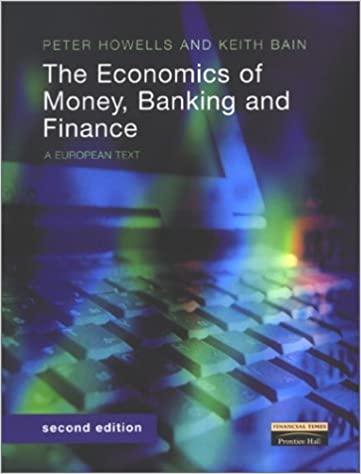Question
As a firm increases risk of the projects, the debt holders charge higher inter- est rates. But this implies even a greater incentive to take
As a firm increases risk of the projects, the debt holders charge higher inter- est rates. But this implies even a greater incentive to take on more risk, so in some instances creditors may ration credit (do not lend) altogether. Suppose that Unique Corporation can take one of two mutually exclusive projects (A or B), each costing $200 mil. Project A gives $270 million next year with probability 0.8, or $100 million next year with probability of 0.2. Project B gives $310 million next year with probability 0.2 or $100 million next year with probability 0.8. Suppose that the probability of success of either project A or project B is uncorrelated with the market, so that the appropriate discount rate is the risk-free rate, which is 5%. Unique Corporation is trying to finance the project with zero coupon debt that will be due next year.
A) If the firm has enough cash to finance the project, which project should it take?
B) Suppose now that Unique Corp does not have any cash and needs to raise money through debt to finance the project. Suppose also that bondholders believe that the firm will take project A and apply a risk-free rate to their loan. What face value of debt, F, should the firm promise to bondholders in order for them give today $200 million to finance the project? (Hint: Take into account that in unfavorable state the firm may not pay back the promised amount F.)
C) Given the promised face value that you found in b) which project (A or B) will shareholders prefer and why?
D) Suppose now that bondholders believe that the firm will take project A, but apply a 15% rate to their loan. What face value of debt, F, should the firm promise to bondholders in order for them give today $200 million to finance the project?
E) Given the promised face value that you found in d) which project (A or B) will shareholders prefer and why?
F) What is the value of debt (use a 15% rate) to bondholders given the choice of the project in e)? Should they lend $200 million?
I calculated A) to be [.8(270)+.2(100)]/1.05 = 224.76, so project A is the project to choose due to higher NPV than B
I basically just need help with how to calculate the face value of debt (an equation) the firm should promise so the investors will give the $200 million that is needed by the firm, I think I will be able to calculate the rest after that.
Step by Step Solution
There are 3 Steps involved in it
Step: 1

Get Instant Access to Expert-Tailored Solutions
See step-by-step solutions with expert insights and AI powered tools for academic success
Step: 2

Step: 3

Ace Your Homework with AI
Get the answers you need in no time with our AI-driven, step-by-step assistance
Get Started


